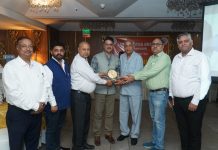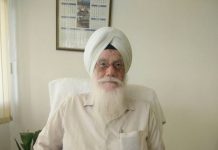Chandigarh
22 July 2018
DIVYA AZAD
The best treatment for heart attack is to attack it within the golden hour, before it damages the heart or kills the patient. These words of advice, coming from a doctor who has 13,000 angioplasties from the wrist under his belt, received rapt attention from an audience comprising scores of his post-operated patients and opinion makers from across the Tricity at an awareness lecture held at Hotel JW Marriott here on Sunday.
Speaking on the topic ‘ POST PTCA AFTER CARE- The things to be followed by patients after percutaneous coronary angiography (PTCA) / Stenting’, Dr R K Jaswal, DM Cardiology, Director Cardiology, Fortis Hospital Mohali, informed the audience that adherence to proper medical follow-up and maintaining a healthy lifestyle after undergoing a heart procedure are absolutely essential for the well-being of the patient. He said studies showed that > 70% blockages are treated by stents and blockages <70% are managed by medical treatment and lifestyle modification.
Dr Jaswal, who during his more than 22 years’ experience in the field of Interventional Cardiology, has performed more than 30,000 invasive cardiology procedures and more than 13,000 coronary interventions, including complex and high risk coronary interventions, said: doctors, patients and their family members should be well aware of the care and follow-up techniques, he added.
He said it had been scientifically proven that post-heart procedure care is beneficial to the patients, to the effect that in retrospective analysis of 2,395 patients, it was noted an approximately 45% reduction in mortality among 40% of patients who participated in cardiac rehabilitation trial.
Dr Jaswal, who has the largest experience in entire north India of more than 30,000 transradial invasive procedures and more over 13,000 trans-radial interventions including complex procedures, said PTCA and stenting, especially through the wrist artery has been proven to be extremely comfortable, safe and long lasting treatment option in majority of coronary artery disease patients. But the results vary depending on key factors like experience of the doctor and the hospital, besides the level of care available at the hospital.
Patients who have undergone stenting via wrist route can walk immediately with radial band, but those who have had the procedure through the thigh route have to keep the leg straight in bed for at least 18-24 hours and often complain of backache, difficulty in passing urine and difficulty in eating.
For those who have undergone the procedure through leg artery, things have to be kept in mind are 1) they can walk lightly 6 hours after sheath removal; complete recovery takes close to 1 week. 2) taking the stairs is restricted; sexual activity is to be avoided for 2-5 days and taking a bath or swimming is not advised in first week – taking a shower is okay.
He also observed that complications are virtually nil in the hands of highly experienced transradial operators in high volume centres. Even mortality is very low, he added. The more the experience of the doctor, the more exceptional the results. Also, there are no restrictions if the procedure has been done through wrist route. Lunch is usually served to the patient an hour after stenting.
In post-stenting patients, chest pain, which is typically cardiac in nature and with accompanying ECG changes, warrant an immediate consult by the treating Cardiologist.
























































